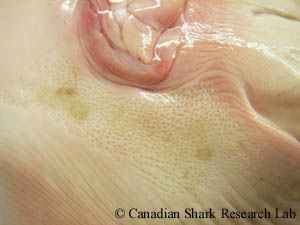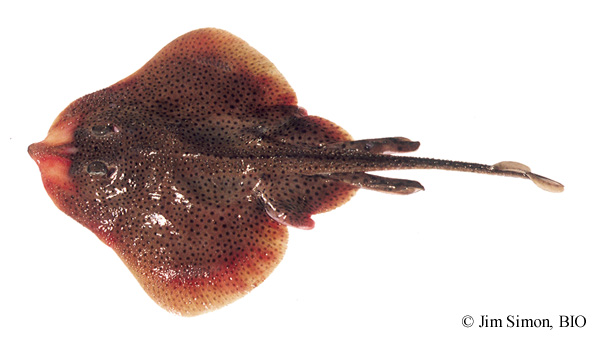Little Skate
Leucoraja erinacea
Description
The little skate has a depressed body, a slender tail, a disc that is approximately 1.2 x as broad as it is long, a snout with an anterior angle greater than 90°, and blunt teeth (although the teeth of mature males may have sharp or blunt points). The upper surface of the disc - especially in females - is rough with a distinct spine pattern. Specifically, there are 2 to 4 irregular rows of thorn-like spines on either side of midline of the disc extending to the anterior part of tail; an irregular triangular group of 30 to 60 spines on neck and shoulder region; 3 to 8 spines behind eye; 8 to 15 spines in front of the eye; 9 to12 spines along inner margin of the orbit and several spines between the orbits. Young little skate have a row of strong median spines that are usually lost when the fish reaches approximately 30.5cm. Also, on the lower surface of the snout region, there are a few spines. Otherwise, the ventral surface is smooth. The little skate has two dorsal fins joined at their bases and located near the end of the tail. There are lateral folds on posterior two-thirds of tail, and the caudal fin is very small. The pelvic fins divided into distinct anterior and posterior lobes, and are overlapped by the pectorals. Colouration in the little skate is grayish to dark brown on the dorsal surface, usually with small oval darker spots, and white to pale gray on the ventral surface.
Little skate are difficult to distinguish from winter skate (Leucoraja ocellata), particularly at sizes below 30 to 35 cm TL. As such, examination of a combination of characters is necessary to differentiate between the two species. In little skate, the mouth is more strongly arched or bowed. Female little skate have small pelvic spines very near the cloaca that are rough to the touch, whereas the pelvic spines in female winter skate are more toward the outside edges of the pelvic fins. Male winter skate have pelvic spines but male little skate do not. Tooth counts have also been used to differentiate the two species. Little skate have 30-62 rows of teeth in the upper jaw, whereas winter skate have 63 or more rows. However, tooth count in both species varies considerably with size of the fish, making this a difficult means of distinguishing between the species. Genetic analyses are the best way to identify little and winter skate below 30 - 35 cm TL. Specifically, a polymerase chain reaction - restriction fragment length polymorphism (PCR - RFLP) assay is used to genetically differentiate between species.

Size
The little skate is one of the smallest species occupying waters off Atlantic Canada. It reaches a maximum length of approximately 53 to 59 cm TL. There may be some geographic variation in maximum size (see Life History section).
Range
The little skate is found only in the northwest Atlantic Ocean, where it ranges from southeastern NewFoundland and the Scotian Shelf, the Bay of Fundy, and Georges Bank southward to North Carolina. It does not occur regularly north of LaHave Bank on the eastern Scotian Shelf, and is most abundant in the Georges Bank - Delaware Bay region. The little skate is sympatric with the winter skate (Leucoraja ocellata), sharing its distribution with the later throughout its range.
Habitat
The little skate is a benthic species that lives primarily on the continental shelf over sand or gravel bottom, often in shallow water (i.e. at depths less than 111m). However, it has been taken at depths of 329 m on Georges Bank . The little skate can tolerate a relatively wide range of temperature (1.2 - 21°C), but is more often caught in cooler waters (2 - 15°C). In Canadian waters (i.e. Passamaquoddy Bay off the Bay of Fundy ) the little skate appears to prefer lower temperatures, and has been classified as "winter periodic", moving inshore in the winter and offshore into deeper water in the summer.
Life History
The little skate is one of the fastest growing species of NW Atlantic skates studied to date. Studies on age, growth and maturity have demonstrated that this species also matures at a smaller size and earlier age and is less long-lived than other species of skate in Atlantic Canada waters. For more information on how life history characteristics are determined in NW Atlantic skate, go to the Skate Research section of this website or refer to the references listed in the table below.
| Area | Max size (cm) | Longevity (yrs) | Size-at-maturity (cm) | Age-at-maturity (yrs) |
|---|---|---|---|---|
| US northeastern coastFootnote 1 | 57 | 12.5 | 43.0 - 46.0 (female) | 6.5 - 7.0 (female) |
| New England/Georges BankFootnote 2 | 53 | 8 | approx 42.0 - 50.0 | n/a |
| eastern Scotian ShelfFootnote 3 | 59 | 12 | 48.4 (male) 46.4 (female) |
7.1 (male) 6.9 (female) |
Diet
The little skate feeds primarily on decapod crustaceans and amphipods. Polychaetes are also of importance, followed by isopods, mollusks, and fishes (the later being of only minor importance). The proportion of each prey type consumed seems to vary with geographic region. Studies of the food habits of the sympatric little and winter skate (Leucoraja ocellata) indicate that they may avoid serious competition by eating either different prey or different proportions of the available food through opportunistic feeding. Specifically, the little skate appears to eat more epifauna, while winter skate feed predominantly on infauna.
Reproduction
Little skate along the US northeastern coast exhibit a partially defined annual reproductive cycle with peaks in reproductive activity and egg deposition in June-July and late October-January. Mating is thought to occur throughout the year. Development within the egg case is thought to be temperature dependent, with time to hatching varying from 6 to 9 months. Young little skate are approximately 9.5 to 10 cm TL when they emerge from the egg case. For more information on how reproductive cycle is determine in NW Atlantic skate, go to the Reproduction Research section of this website.
Interaction with people
Landings of little skate taken as bycatch have expanded in response to declines in traditional groundfish stocks, especially in US waters such as the Gulf of Maine. Large numbers are caught incidentally in otter trawls, traps, and weirs, and are used for lobster bait and in the manufacture of fish meal. This species is also used as a laboratory animal in biochemical and physiological studies. In Canada on the eastern Scotian Shelf, little skate abundance appears to have increased in recent years, perhaps due to a decline in winter skate (with which the little skate is sympatric).
Interaction with people
Also called "tobacco box" and "hedgehog skate".
- Date modified:



